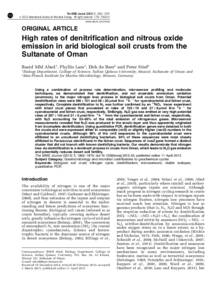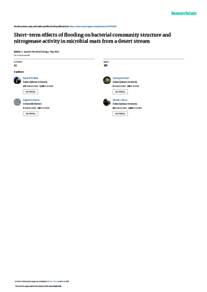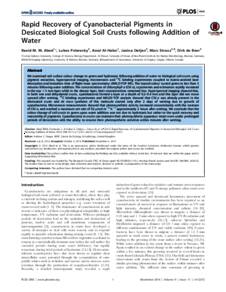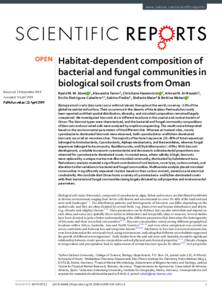وثيقة
Bacterial diversity, pigments and nitrogen fixation of biological desert crusts from the Sultanate of Oman.
المعرف
DOI: 10.1111/j.1574-6941.2010.00854.x
المساهمون
الناشر
Federation of European Microbiological Societies.
ميلادي
2010-03
اللغة
الأنجليزية
الملخص الإنجليزي
Biological desert crusts are relatively common in the arid deserts of the Sultanate of Oman; however, little is known about their microbial community composition and role in soil fertilization. We compared three crusts from geographically different locations for their soil texture, bacterial community structure, pigment composition and nitrogenase activity. The crusts were growing on alkaline (pH 7.6-8.7) loamy sand and silty loam soils. Microscopically, Microcoleus vaginatus was the most abundant cyanobacterium, but Nostoc and Scytonema types dominated in cultures. The 16S rRNA gene sequences showed close similarities in the crusts' bacterial composition, with 77-81% of the total clones belonging to cyanobacteria and the rest distributed among Alpha- and Deltaproteobacteria, Bacteriodetes, Gemmatimonas and Planctomycetes. Thirty-seven percent of the cyanobacterial clones were affiliated with heterocystous types such as Nostoc, Scytonema, Brasilonema and Petalonema. Chlorophyll a concentrations suggest a similar abundance of phototrophs in all crusts. High levels of the UVA sunscreen scytonemin were detected in the exposed crusts. The three crusts exhibited comparable acetylene reduction rates in the light and in the dark, with a maximum rate of 58.5±2.6 μmol C 2H2 reduced m-2 h-1. We conclude that the crusts, regardless of their geographical location, were rich in heterocystous cyanobacteria that can fix nitrogen and could possibly improve soil stability and productivity.
المجموعة
ISSN
0168-6496
URL المصدر
قالب العنصر
مقالات الدوريات






